A Gentle Introduction on How to Use Anki to Improve Your Memory

Where would you be in life if you did not forget?
You would have done better in school, for starters. Instead of turning in your bed unable to sleep terrified of the exam coming the next day, you would soundly sleep with the knowledge that you know everything you need to know to ace the exam. And ace it you would indeed.
You would have spent fewer hours studying. How many times have you opened the textbook only to find that you’ve forgotten all that you’d studied the day before? If you did not forget things then those hours you spent studying would always amount to something, instead of leaving you feeling like you’re swimming against the current. School might even have been fun if you did not forget.
What would your career look like if you did not forget?
Forgetfulness affects us all. There is no one that has not grappled with this problem before. Our lives would be better if we did not forget.
Unfortunately, forgetting is inescapable. There is no such thing as a perfect memory. I am not here to sell you on a magic pill that will turn you into Bradley Cooper in the movie Limitless.
However, that doesn’t mean there aren’t things you can do to massively reduce the speed at which you forget things, because there are.
Science has known about what it takes to get memories to stick around in your memory for a long time. It has known about it for a while now, in fact. It’s just that it has done a terrible job so far at making sure that you know about it, you whose life would massively benefit from that knowledge.
My intent for writing this is to correct these wrongs and introduce you to spaced repetition, the more than established method that will put you in control of your memory once and for all, and Anki, the software that will help you do so.
So, let’s start at the beginning: What is spaced repetition?
The Centuries Old Science They Don’t Tell You About
More than a hundred years ago, the German psychologist Hermann Ebbinghaus not only started the scientific study of memory, but he also made its most impactful discovery.
After all, what discovery could be more impactful than what makes memories stick?
Ebbinghaus created various lists of nonsense syllables that he had to memorize, and once he was able to mouth off the entire list without making a single mistake he would mark on his calendar the day where he had to memorize that list once more.
He would have to memorize some lists the day after, others a week and some a whole month after he had first memorized them. Doesn’t sound much fun, does it? This is especially true when you take into account each list must have taken him quite a long time to memorize since by design each of the three-letter syllables he had to study had been chosen so that they weren’t easily remembered. For example, the syllable BOL was out of the question as Ebbinghaus could instead use BALL to recall it.
After the requisite time had passed, to measure the extent to which he had forgotten the list he’d spent so much time memorizing, he memorized the same list once more. Not only did he have to sit still in his office for a long time trying to memorize a bunch of nonsense words once, he had to do it twice! Throughout his second attempt he did have some help since it would take him less time to memorize the list the second time around if he remembered it from his first foray cramming it into his memory.
If by that point he’d already forgotten it, then it would take him at least as much time to memorize the list the second time as it had the first. However, if some memory of it still lingered in the confines of his mind, he would be able to go through the list faster than before. By varying the amount of time between each attempt, and seeing how that influenced how long it took him then to memorize the list the second time, Ebbinghaus was able to measure the effect time had on his memory.
And what an effect it had.
The first thing he noticed was that memories are at their most fragile when they are still young. From the data he’d collected, he could see that the bulk of forgetting happens in the few moments after the memory is created. Rather than forgetting happening at a linear pace over time, each day that passes nicking a constant amount of the vitality of a memory until it is completely forgotten, Ebbinghaus discovered forgetting happens rather rapidly at first but slows down afterward.
In the first few hours of its life, it’s as if your newly created memory has jumped out of a flying airplane and is now free-falling through the sky, the wind buffeting its face violently as it quickly loses altitude. As the ground becomes uncomfortably close, our memory activates its parachute and begins to glide, still falling, of course, but much slower than it was when it first jumped out of the plane. Now, to be sure, the forgetting curve, as this discovery came to be called, is an important landmark in the scientific study of memory, but it’s not a particularly useful one. We forget things over time; what a discovery! You don’t need to be a top-level scientist to come to that conclusion. It’s why we’re here in the first place!
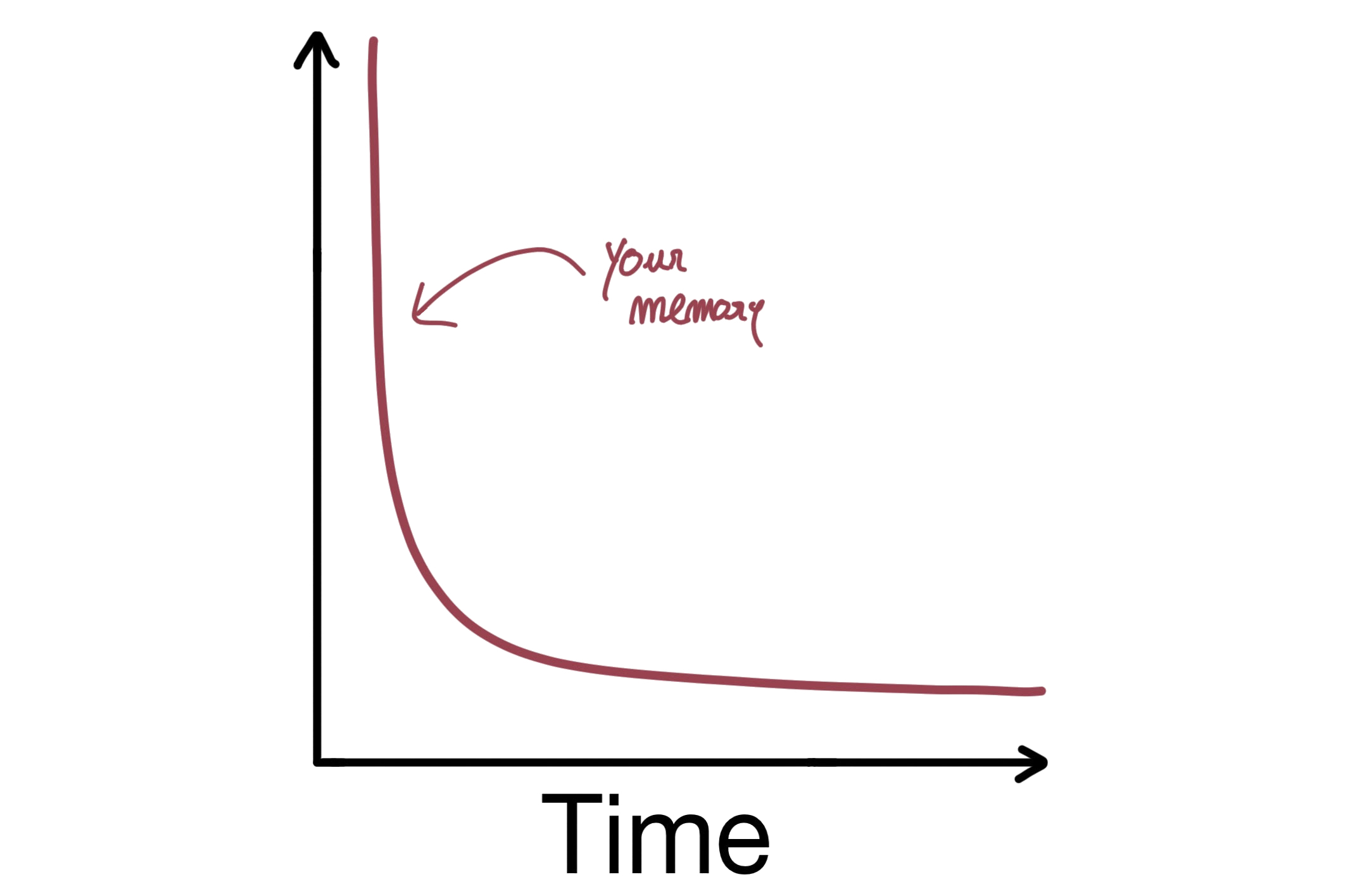
Behold, my superlative drawing skills!
But Ebbinghaus didn’t stop there. When he first started learning his lists of nonsense syllables, Ebbinghaus, like many a student, crammed all his studying in a single furious session. But then, possibly because he was fed up with all the cramming, he hit upon the idea of spreading his learning over time. Instead of spending the majority of a day learning one of his lists, he spaced out his learning over a few days. What he found when he did so is the most important discovery about memory that no one ever told you about.
You would think not much would change if instead of studying a bunch of material in one day you did so over three or more days. But what Ebbinghaus found was that not only did his memory get stronger, but it also took him less time to memorize his lists. This meant that simply by changing when he studied, Ebbinghaus could have the best of both worlds: a better memory with less time spent studying.
It need not be pointed out how important a discovery this is. If someone came up to you and told you about a revolutionary studying method that would not only cut the time you spent studying but also get you to retain the things you learn for longer, you would think you were being sold on some sort of scam.
Yet the spacing effect, as Ebbinghaus’ discovery is called, is far from being a scam. It is one of the most scientifically supported discoveries in the entire field of psychology.
The gist of the spacing effect is rather simple. Given the choice between massing all your studying or spacing it out over a period of time, you are better served by spacing it out. There is no catch. It really is that simple.
This means if you are a student and you have an exam coming up a month from now, you should start studying now rather than waiting until a single week is left. If, for example, you’re going to spend 50 hours studying, then spreading those hours over the whole month, ensuring that you get re-exposed to the material in sufficiently spaced intervals, would get you much better results than you would if you crammed those 50 hours in a single stress-filled and coffee-fueled week.
Of course, that’s easier said than done.
The spacing effect is one of the most important weapons a learner can have on his arsenal but knowing about its amazing effects does not mean that we will necessarily apply it. After all, we all know not to eat too many processed foods do we not? Yet, that doesn’t seem to stop many of us.
Pulling an all-nighter to cram for an exam is like binging on a sugar-filled pastry when one is trying to lose weight, yet the fact it continues to be a staple learning strategy of many a student is a testament to how difficult it can be to embrace the lessons of the spacing effect.
If only there were an app for that…
This App Will Turn Your Memory Into A Superpower
One hundred years ago Ebbinghaus didn’t have a computer, let alone a smartphone. If he’d had them they would have taken care of the task of spacing what he had to learn for him. Instead, he had to do all of that himself, though if we consider that he was the kind of guy that did not balk at the idea of spending hundreds of hours learning endless lists of nonsense, perhaps he wasn’t that fazed by it.
Thankfully, today we have tools that manage all of that for us.
And it all starts with a simple flashcard.
Everyone knows how a flashcard is supposed to work. You write something on the front, then something on the back, and then you’re supposed to recall what it was that you wrote on the back after reading what’s on the front.
Suppose that in the process of studying for a coming exam, you wrote many of these flashcards. You have a big pile of them sitting on your desk and within them are all the things you have to know if you want to ace that exam.
Because you know about the spacing effect, you know that cramming those flashcards is a bad strategy, but then how are you supposed to space them out? There are so many cards to keep track of…
What if those flashcards existed on your computer instead?
If that were possible, then the computer could take care of the task of keeping track when you’re supposed to review your flashcards and you could focus solely on the things that matter, which, in this case, is answering your flashcards correctly and acing that exam.
Which is why spaced repetition software was invented: to take care of all the grunt work so you can easily add spaced repetition into your life.
At its core, all spaced repetition software does is keep track of when to present you with the material that you put in it. It’s called spaced repetition software because they use special algorithms to calculate the optimal interval between when you last reviewed the material and when you’re supposed to review it again so you can get all the benefits of the spacing effect.
This might not seem much at first, but spaced repetition software is a revolutionary type of software and starting to use it is of the most impactful decisions you can make. Why?
Because spaced repetition software makes memory a choice.
Think of it this way: forgetting is inescapable. The forgetting curve is a mean mistress and will pull all your memories down with it. However, the spacing effect tells us there are ways to weaken the forgetting curve’s pull and get memories to stay fresh in your mind for longer. What spaced repetition software does is to automate the job of tracking which memories have become weaker with time so that it can present them to you and thus, through the magical effects of the spacing effect, bring them back to life stronger than ever.
If the software deems one of your memories to still be strongly rooted within your mind, then it won’t show it the material. If it thinks instead that you’re about to forget the material it will put it in front of you for you to review.
As long as you keep using the software, then anything and everything you put in it has the potential to become something that you remember forever.
Pretty nifty that, is it not?
So, which spaced repetition software should you use?
A Gentle Introduction to Anki
If the title didn’t give it away, use Anki.
There are many other kinds of spaced repetition software out there but you should use Anki. There’s a reason it’s the most popular spaced repetition software in the market. It has most of the features you will need and those it doesn’t are available as an add-on by the Anki community.
Best of all, it’s free, and I will show you how you can use Anki to improve your memory.
To start using Anki, you will need to install it. You already know this of course, but it never hurts to start with the very basics.
Once you’ve installed it, you will be presented with the following screen:
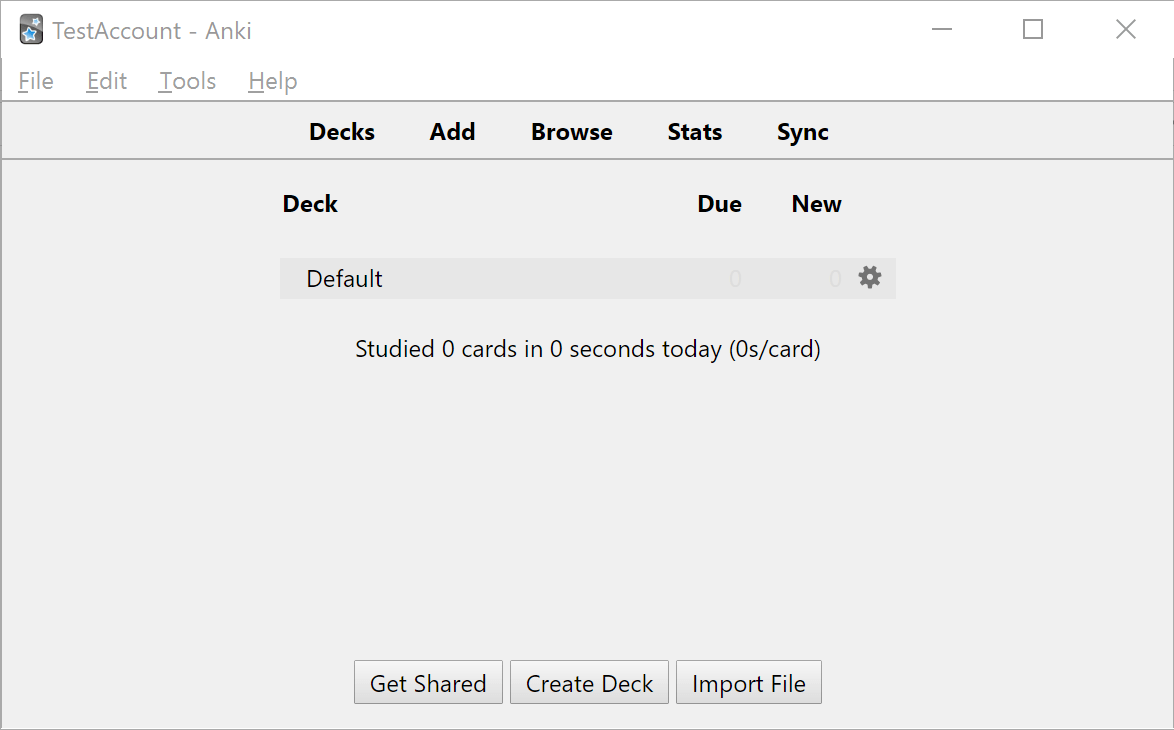
This is the main Anki window and it shows the Decks you have in your collection. A Deck is just a group of cards. You can have as many decks as you want - although Anki struggles when you have a lot of them - but for most people, a single deck will suffice.
On the top menu above there is an Add button. Click on it. It’s time we create our first card.
Once you click on the Add button, this window will appear:

This is where Anki can become a bit confusing, but I will demystify it for you.
Know that although Anki is a powerful piece of software, you can do without knowing most of its features and intricacies. You get the bulk of its benefits solely by using it, so you’re better off using it even when you do not understand how all of it works than never using it at all. As the saying goes, perfection is the enemy of good and to use spaced repetition to develop a stronger memory, just using Anki is more than half the battle won.
The first thing to understand about how Anki works is that a Card - like the flashcards you already know about - is created from a Note. When you click the ‘Add’ button, the thing you’re adding is a Note, out from which one or more cards will be created by Anki.
In the picture above, the Note I created has two Fields: Front and Back.
The Front is where you put your question, and the Back is where you put, you guessed it, the answer to that question. It works very much like regular flashcards. You put questions on the Front and answers on the Back.
Using an example from my Deck, here is a card that I added not too long ago:
Front: Amygdala is Latin for what?
Back: Almond
When Anki deems that it is time for me to review this card, it will show me “Amygdala is Latin for what?” and I will have to answer, “Almond”. If you’re wondering why I added this to my collection, it’s because I was reading about the brain and I thought it interesting the amygdala is called that because it is shaped like an almond. I wanted to remember that interesting fact, so I added it to my Anki collection. Now I’ll never forget it. That’s the power of Anki; it puts your memory under your control.
Once you put your question and answer into Anki and click on the ‘Add’ button below, Anki will pick both the Front and Back fields and use them to create a card with the Front as the question and the Back as the answer. However, Anki will only create cards that way because it has been told to do so.
If you look back at the image above, there is a little option at the top titled Type. A Note Type dictates how many fields a note has and tells Anki how to use them to create cards. In our previous example, the Basic type dictates that a note have two fields, Front and Back, but you can create your own note types to suit your personal needs.
By default, Anki comes with two note types installed: The Basic, which we’ve already met, and the Cloze.
The Cloze note type was created with cloze deletion in mind.
Cloze deletion, admittedly a rather strange name, is when a portion of a text is omitted, and you have to remember what fills in the blank. If instead of, “This is a cloze deletion” I wrote, “This is a ____ ______”, then it would be your job to fill in the blank with ‘cloze deletion’.
To create a card using the Cloze note type, click where it says Basic; this will open up a window showing all available types for you to choose from. Select Cloze. Now you’re ready to create your first Cloze card.
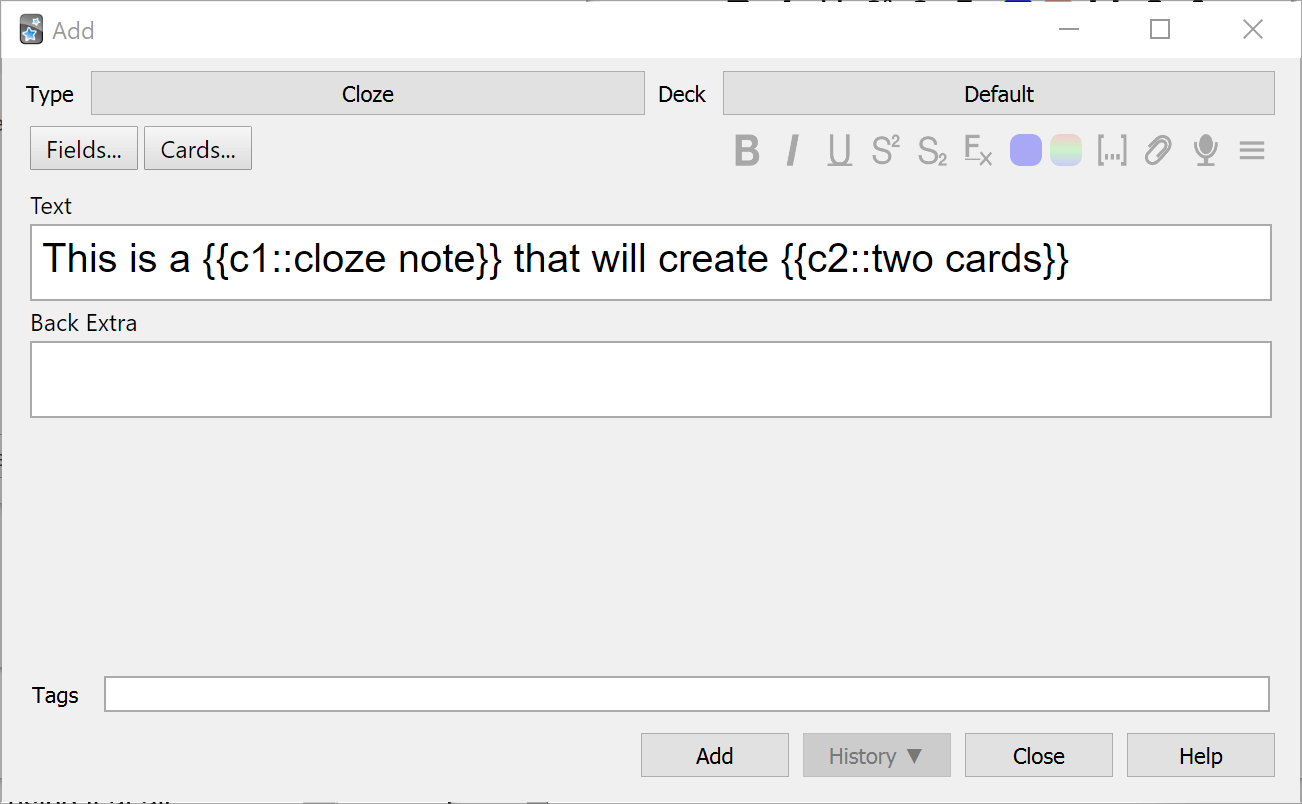
Whereas before you had to add a question and an answer to create a card, for the Cloze type you merely have to tell Anki which portions of the text you want it to test you on. To do so, you need only select the portion of the text you want, go to the toolbar above, and select the fourth icon from the right, the one that looks like this […].
In the image above, I selected two pieces of the text, “cloze note” and “two cards”. Anki, knowing that this card is of the Cloze type, will create two cards from this single note. The first card looks like this:
This is a [...] that will create two cards
Whereas the second one looks like this:
This is a cloze note that will create [...]
To answer these cards correctly I need only fill in the blank.
This is a […] that will create two cards ⟶ This is a cloze note that will create two cards
and
This is a cloze note that will create […] ⟶ This is a cloze note that will create two cards
The cloze type is very useful, as you can see. I recently used it to create four cards that test me on my knowledge of the brain’s anatomy. I wanted to learn the names of the four lobes of the brain, and to do so I created the following note:
The four lobes of the brain are:
• {{c1::Frontal}} lobe
• {{c2::Parietal}} lobe
• {{c3::Occipital}} lobe
• {{c4::Temporal}} lobe
Anki created four cards from this single note, one for each lobe. When the time comes to review one of those cards, Anki will show me:
The four lobes of the brain are:
• Frontal lobe
• Parietal lobe
• Occipital lobe
• [...] lobe
And I will have to answer: Temporal lobe.
It is unlikely you will ever have to create your own note types. The Basic and Cloze will cover most of your needs, and because perfection is the enemy of the good enough, trying to squeeze all efficiency out from Anki by creating your own hyper-specific types will only backfire when you find yourself not using Anki because it is too much work.
Keep things simple and you won’t fall off. Remember, just using Anki is more than half the battle won.
Now that you’ve added your first cards, it is time to review them. To do so, click on your deck in the decks’ list and then click on the Study Now button.
Because I created the cards I was showing you above, this is what appears to me when I do so:
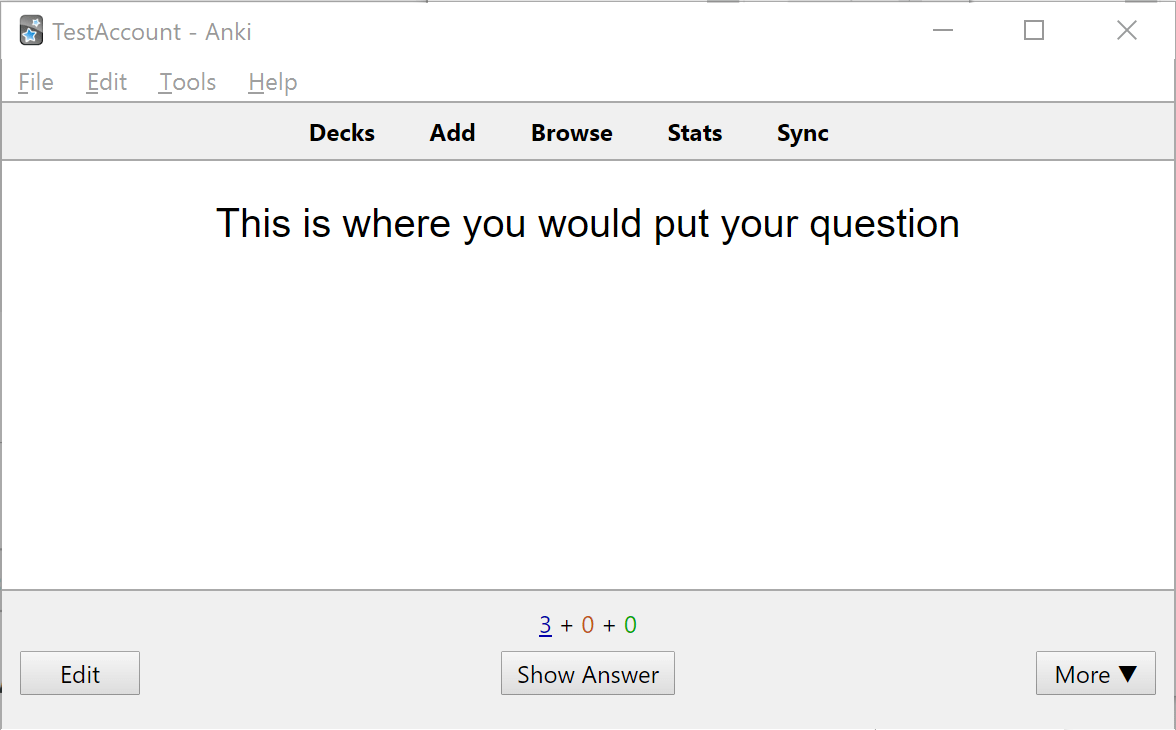
Now I need to try and remember what the answer to this is. Because this was just an example there’s no answer for me to remember, but if the question were to be, “Which spaced repetition software should you use?”, my task would be to recall “Anki”.
When you have the answer in mind, or if you are incapable of recalling it, you click on the Show Answer button.
As you probably figured out, Anki will show you the answer:
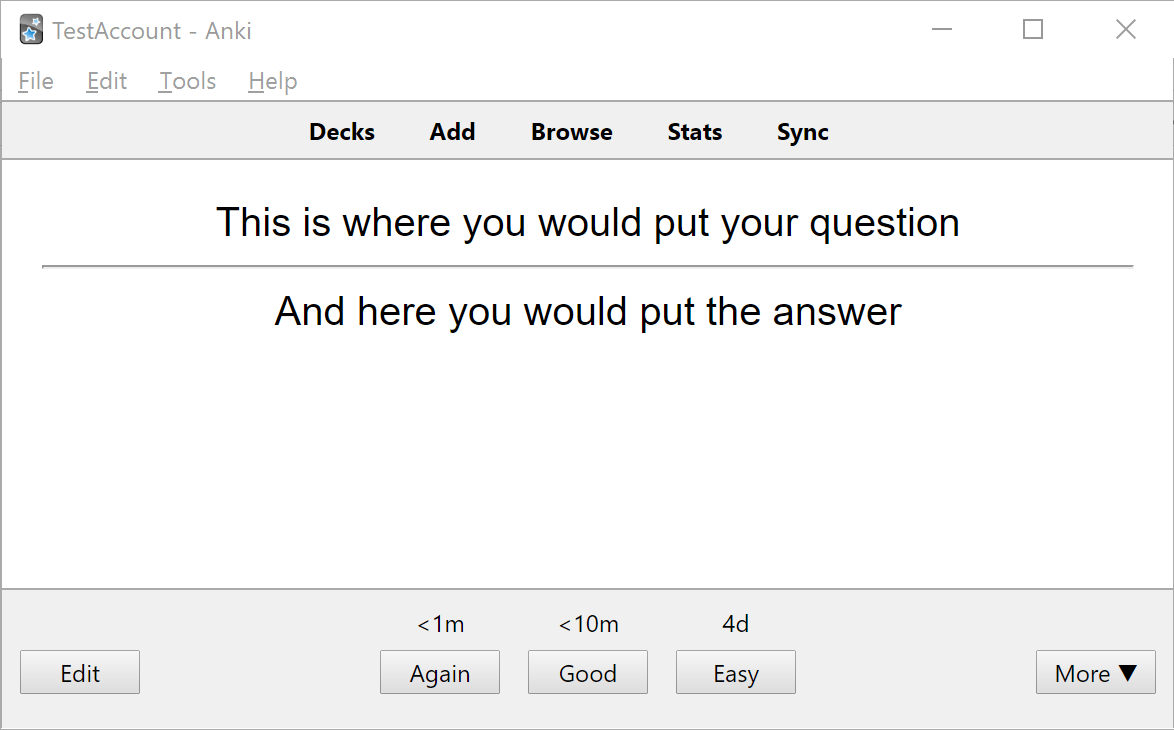
Now comes the time for you to grade your memory.
In the image above, there are three options: Again, Good, and Easy. They are ordered by degree of difficulty in remembering the answer.
If the memory has vanished entirely from your mind, then you select the Again button. That tells Anki that you need to spend more time with the material, and it will make sure to present it you sooner rather than later.
On the other hand, if the answer came to you instantly, that means your memory of it is strong. By selecting the Easy button Anki will know that you likely do not need to review the material for a while.
Here is one example of the options that appear in one of the cards in my personal Deck I have to review today.

As you can see, I have four options to choose from rather than the three above because I have already encountered this card many times before, whereas the previous card was newly created.
You may also notice that if I choose the Easy option, which I did because the answer to this particular card came to me instantly, Anki will only show it to me again approximately nine months from now.
That is the power of the spacing effect, combined with the magic of Anki, in action.
What were the chances that 9 months from now I would remember I needed to review this question and see how well I still remembered its answer?
None. There’s no way I would remember to do that.
But with Anki, I don’t need to. It takes care of all of that for me.
From calculating the optimal interval to showing it to us, Anki takes care of all the hard work of adopting spaced repetition into our lives. So long as we keep showing up to do our daily reviews, Anki will make sure that we are in full control of our memory.
This means our number one priority should be to make sure we keep showing up for the daily review.
This is no small task. I have known about Anki and spaced repetition for close to a decade now, but it would be a stretch to say that I have been using it for that long. There have been many periods over the years where I have completely fallen off using it. It’s not that I forgot about Anki and the many benefits of spaced repetition - that would be ironic - but rather it is rather easy to fall into a trap where doing your daily reviews becomes a chore where you know that opening the program will bring little pleasure, and a whole lot of hurt.
This can happen for a variety of reasons.
A common failure mode when starting out is to start throwing things willy-nilly at it in the hopes that Anki will somehow get it all into your thick head. For example, many people start out by adding all the capitals of the world. That sounds like a fun thing to memorize, right?
Yet eventually they find that they never really cared about it in the first place, but now each time they open Anki they’re being asked to come up with the name of those capitals. Because they don’t care that much about it, they don’t answer them correctly. Maybe they keep confusing Minsk with Ljubljana, or for the life of them, they can’t come with the name of the capital of Perú. And since they keep getting those questions wrong, Anki keeps showing the same cards to them over and over again, cards they don’t care about things that hardly matter to them. They enter into a vicious loop, a loop that quickly saps away all the fun there is in learning cool new stuff.
As I’ve said before and will continue to stress, the most important thing is to keep using Anki. Your priority, first and foremost, is to make sure that you stick with it.
The path to a better memory starts with spending a handful of minutes a day with Anki. and in this article I share some of the tips and strategies that have helped me make sure that I don’t fall out of doing my daily reviews.
Get more content like this!
Increase your cognitive fitness with the best strategies and advice to help you make the most of your mind.
I hate spam as much as you. Superpowered Self will only send you quality content.
